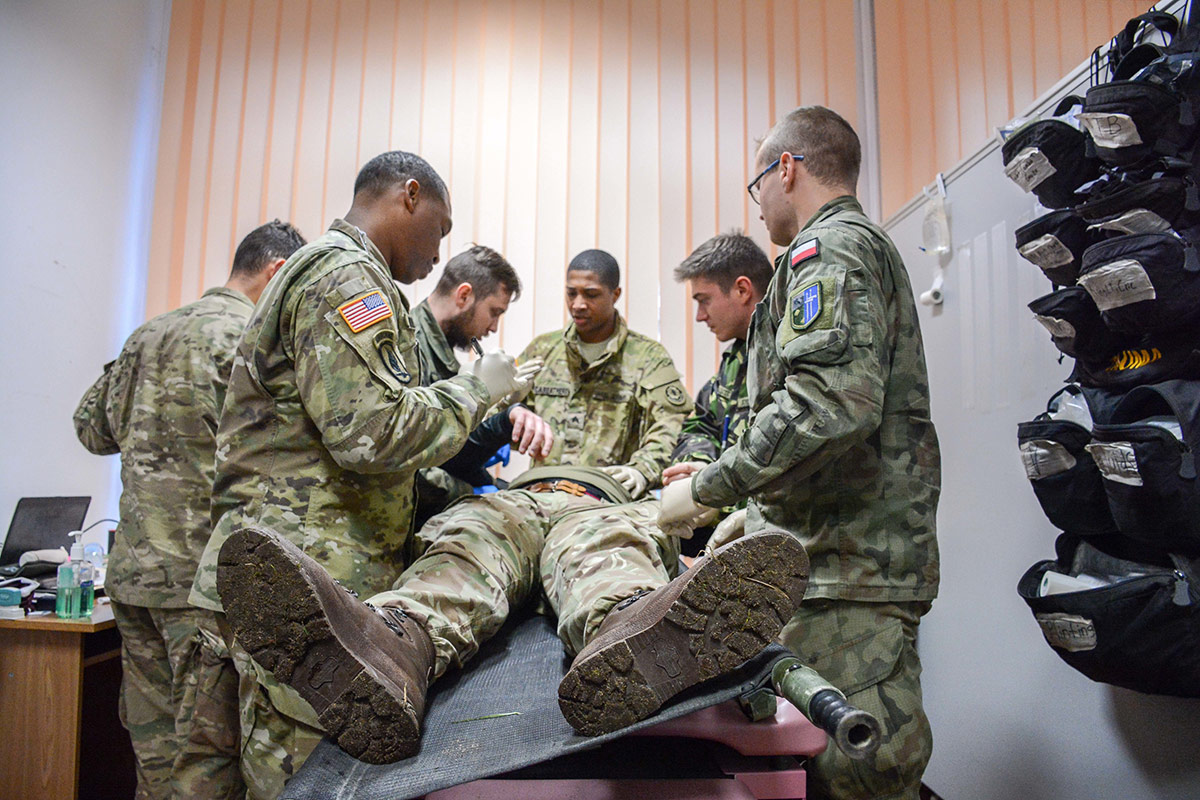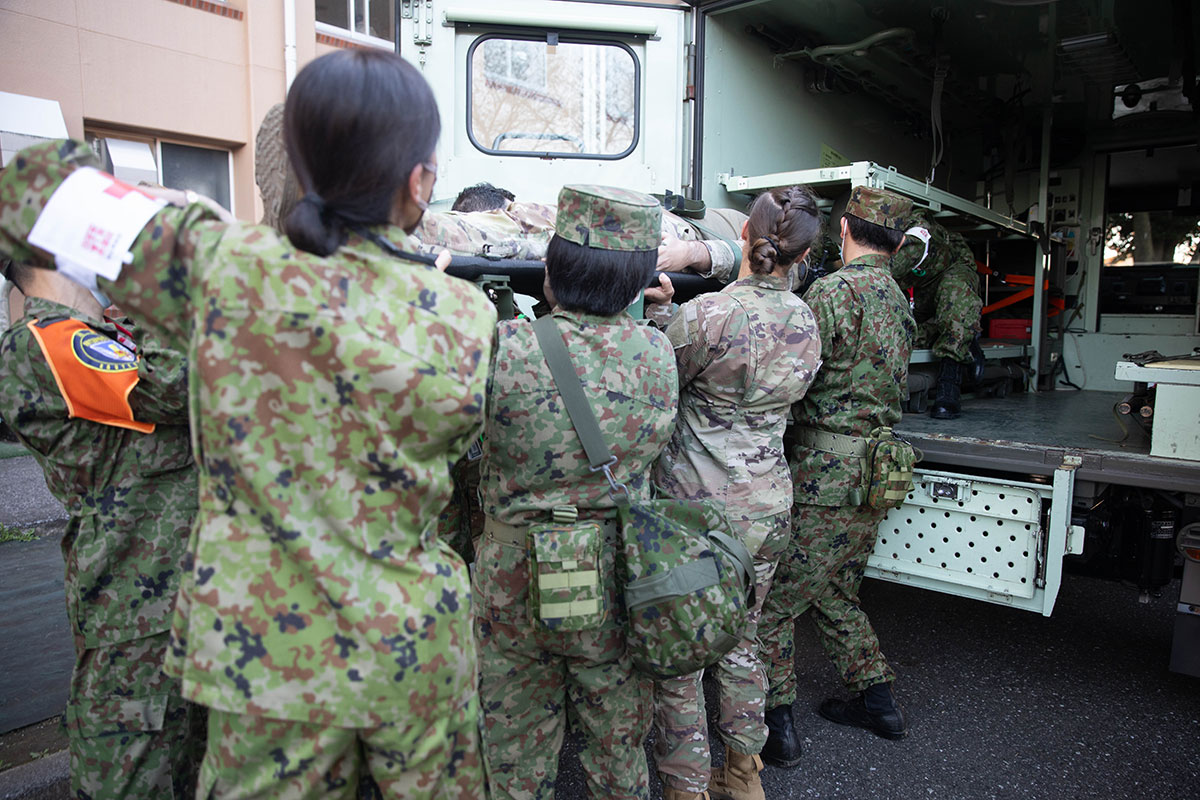Enhancing Joint Medical Training and Interoperability
A Path Toward Integrated Care Across NATO and U.S. Forces
By Captain Bivor Shrestha
Article published on: November 22, 2024 in the November 2024 Issue of the Pulse of Army Medicine Journal
Read Time: 6 mins
Abstract
In modern military operations, from counterinsurgency (COIN) to large-scale combat (LSCO), the success of missions often hinges not only on the effectiveness of combat forces but also on the ability of coalition forces to provide rapid, effective medical care. This is particularly true for Role 1 medical facilities, which are the first point of care for injured service members and play a crucial role in saving lives and maintaining combat effectiveness. Given the multinational nature of many deployments, especially within NATO coalitions, the interoperability between U.S. forces and allied medical teams is paramount. This article examines the medical capabilities of U.S. and NATO partner forces, identifying common strengths, notable differences, and opportunities for improving interoperability through joint training and shared practices.
Medical Capabilities: Strengths and Challenges
During a nine-month deployment in the CENTCOM Area of Operations (AOR), Role 1 medical teams from the U.S. Army collaborated with coalition forces from Germany, Italy, the United Kingdom, France, Finland, and Estonia. The Role 1 facilities in these nations varied significantly in terms of medical equipment, personnel composition, training, and capabilities. Nonetheless, several critical themes emerged in fostering effective interoperability.
One key observation was that while many NATO forces share similar medical team compositions and foundational training, such as Tactical Combat Casualty Care (TCCC), there are notable differences in specific capabilities. For instance, some nations, like the U.S. and Germany, have extensive surgical and ventilation capabilities at their Role 1 facilities. In contrast, others, like Italy and Estonia, face limitations in advanced equipment, such as mechanical ventilators or point-of-care diagnostic tools like ultrasounds. Despite these differences, the teams demonstrated remarkable ingenuity in maximizing their available resources, ensuring patients received effective care in the most challenging environments.
In particular, the absence of physician assistants (PAs) in deployed environments among many NATO partners is noteworthy. While the U.S. Army extensively utilizes PAs as force multipliers in Role 1, providing additional capacity for patient care, most of its partners did not have equivalent roles. Instead, many Role 1 facilities were staffed with a smaller number of doctors and nurses, sometimes supplemented by medics with specific trauma care training. This disparity underscores the potential value of training partner forces to incorporate additional mid-level providers, such as PAs, into their medical teams.
Training and Standardization: Bridging the Gaps
A recurring theme across the coalition forces was the importance of training. While all Role 1 facilities in the AOR had personnel who were trained in trauma care and basic life support, the methods and depth of training varied. For example, some nations focused heavily on specialized training for specific medical roles, while others emphasized broader, more generalized training to ensure that all personnel were equipped to respond to a range of medical emergencies. This divergence in training approaches highlights the potential for greater cross-training between U.S. and NATO forces to be invaluable.

A group of medical soldiers from the 3rd Squadron, 2d Cavalry Regiment, the Polish 15th Mechanized Brigade, the United Kingdom’s Light Dragoons and the Romanian Army’s Ground Base Air Defense Black Bats conduct joint medical training, Oct. 31, 2017.
Medical teams from various countries commonly suggested joint training exercises, where personnel from multiple nations could practice together in simulated casualty scenarios. This training would help standardize procedures, improve familiarity with each other’s equipment, and foster a deeper understanding of the different medical cultures within the coalition.
Creating opportunities for U.S. and allied medical teams to train in the same environments—using the same equipment and working alongside each other—would break down barriers and enhance mutual trust and confidence.
Additionally, standard operating procedures (SOPs) were identified as a key area for improvement. While each nation has its own protocols for casualty care, a shared SOP across NATO forces would allow for more seamless transitions of care when patients are moved between Role 1, Role 2, and Role 3 facilities, or when they are transported across national lines. This standardization would improve patient outcomes and make coordination more efficient in multinational operations.
Operational Integration: Enhancing Multinational Medical Cooperation
Another key finding from the study highlights the importance of interpersonal relationships in ensuring effective medical cooperation. According to Dr. Matthew Smyth, Senior Medical Officer for the UK, interoperability involves more than just having the same equipment or procedures; it’s also about understanding the thought processes of medical personnel from different nations. Joint training is crucial for building these relationships and fostering a shared understanding of how to work together under high-pressure conditions. Beyond the classroom, informal interactions — through social events or daily collaboration — can help build camaraderie and improve communication during medical emergencies.
Many teams identified a significant challenge in the logistical coordination required to move patients between Role 1 and higher-level care facilities. While most coalition forces rely on U.S. or NATO assets for patient evacuation, there were instances where delays or miscommunications hindered the efficiency of these transfers. This underscores the need for improved coordination in medical care, transport, and logistical support. Joint training in patient evacuation procedures, including the use of dedicated air and ground medevac assets, would greatly enhance the speed and efficiency of casualty evacuation (CASEVAC) and intra-theater medical evacuation (MEDEVAC) processes.
The Role of Technology and Equipment
The variation in medical equipment across coalition forces presents opportunities for collaboration and training. Some nations, such as Germany, have advanced capabilities, including ventilators, portable ultrasounds, and patient monitoring systems that are crucial for managing critically ill patients. However, some Role 1 facilities lack even basic mechanical ventilation, limiting their ability to care for patients in respiratory distress.

Japan Ground Self-Defense Force service members alongside U.S. Army Soldiers load a simulated casualty into a Japanese Armored Ambulance during a trilateral medical training event as part of Yama Sakura 87 at Camp Asaka, Japan, Dec. 3, 2024
To address these gaps, there is a clear need for shared medical resources and better training on the use of advanced technologies. Ensuring that all Role 1 personnel, regardless of their nation, are proficient in using portable ultrasound devices or patient monitoring systems would significantly enhance the quality of care across coalition forces. Additionally, adopting a more integrated approach to medical logistics, such as synchronized resupply chains for medications, equipment, and supplies, would mitigate delays and improve overall operational effectiveness.
Moving Forward with Joint Medical Training and Interoperability
The insights gained from the Role 1 medical teams of NATO and U.S. forces highlight the importance of collaborative training and standardized procedures to improve medical interoperability. While each nation brings unique strengths to the table, the gaps in equipment, training, and operational procedures identified during this study underscore the need for a more unified approach to medical support in multinational operations.
Investing in joint training exercises, fostering stronger interpersonal relationships between medical teams, and standardizing medical procedures and equipment would significantly enhance the ability of NATO and U.S. forces to provide life-saving care in the most challenging environments. These efforts would ultimately strengthen the effectiveness of multinational operations, ensuring that medical support is as agile, responsive, and integrated as the combat forces it supports.
Looking toward future deployments, the true strength of coalition medical support lies not just in the equipment we bring to the fight but in the shared knowledge, trust, and commitment we bring to the mission of saving lives and ensuring operational success.
Author
Captain Bivor Shrestha is an Aeromedical Physician Assistant based out of Fort Drum, New York. Currently deployed as an Aeromedical Physician Assistant with Task Force Nighthawk at Wheeler-Sacks Army Airfield, NY, serving Soldiers from the 10th Combat Aviation Brigade, Army Reserves, National Guard, and multiple coalition forces.